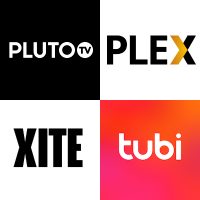 As the streaming wars pick up speed, a lot of the focus has understandably been on the apps produced by the broadcasters and the tech giants. A lot of the headlines this year will undoubtedly go to Disney+’s launch in much of Europe, the launch of France Télévisions, TF1 and M6 Group’s joint service Salto in France, and the debuts of AT&T’s ‘HBO Max’ and NBCUniversal’s ‘Peacock’.
As the streaming wars pick up speed, a lot of the focus has understandably been on the apps produced by the broadcasters and the tech giants. A lot of the headlines this year will undoubtedly go to Disney+’s launch in much of Europe, the launch of France Télévisions, TF1 and M6 Group’s joint service Salto in France, and the debuts of AT&T’s ‘HBO Max’ and NBCUniversal’s ‘Peacock’.
But some of the most interesting and innovative propositions are coming from smaller players who are building businesses by licensing third party content. Below are some of those hoping to take on the giants in the streaming wars:
 XUMO
XUMO
Founded: 2011
Markets: USA, Canada, France, Germany, UK, Italy, Spain, Brazil, Mexico
Method of Monetisation: Ad-supported, no subscription
One of a number of ‘FAST’ (free ad-supported TV) apps to have gained traction in the past few years, XUMO hosts a mix of linear and on-demand channels. These include channels from traditional media brands like NBC, ABC and CBSN, as well as channels from digital native brands like CollegeHumor, Mashable and Tastemade. XUMO also run their own channels, stitching together content into linear broadcasts, and is experimenting with dayparting this content.
XUMO says it collects and tracks user viewing behaviour to power content recommendation. These channels designed to recommend new content to users – a “We Love” channel which runs content popular among all XUMO users, and an “Everyone Loves” channel which recommends content tailored to the user.
XUMO runs ad pods on its linear content, akin to those found on a traditional TV broadcast, which it says are fully addressable.
Several companies have recently been reported to be interested in buying XUMO, with Comcast the most recent rumoured suitor.
 Pluto TV
Pluto TV
Founded: 2014
Markets: USA, UK, Germany, Austria
Method of Monetisation: Ad-supported, no subscription
Another FAST service, Pluto TV’s app offers a mix of curated linear channels which house genre-specific films, TV shows and web videos provided by partners (the company claims to currently have over 130 content partners).
Since its acquisition by Viacom last year, Pluto TV has added channels based around Viacom brands like Comedy Central, MTV, Nickelodeon and Channel 5. Alongside the linear content, Pluto TV has a catch-up service where shows and films can be watched on-demand. And Viacom says it will increasingly make its own shows exclusive to Pluto TV, choosing not to license them elsewhere (the same may now happen with CBS-owned content too, after its merger with Viacom).
Pluto also runs various “pop-up” channels, temporary channels usually focussed on a single show. Last year for example, it ran two channels dedicated to animated series Spongebob Squarepants and reality series The Hills, which can also act as a form of marketing for those shows (The Hills, a Viacom property, was premiering a new series in Germany when the channel was launched).
Pluto TV runs video ads within its linear streams on on-demand content, and also features branded content as an additional revenue stream. The company has been seeking to draw more interest from advertisers, with Viacom saying last year that the company’s sales team sold less than 50 percent of ad inventory.
 Tubi
Tubi
Founded: 2014
Markets: USA, Canada, Australia (UK launch planned for 2020)
Method of Monetisation: Ad-supported, no subscription
Tubi is an ad-supported video on-demand service which pitches it as a free Netflix alternative (it’s recent out-of-home ad campaign directly targeted Netflix and Hulu). Its service in the US claims to have over 15,000 films and TV series through content distribution agreements with studios including Warner Bros, NBCUniversal, MGM and Lionsgate.
The service was made unavailable in Europe in 2018, as Tubi was not at the time compliant with Europe’s general data protection regulation (GDPR). But since then, the company has been attempting again to push into international markets, launching in Australia last year, and with plans to launch in the UK early this year. Tubi also announced it is launching a separate service for children, Tubi Kids, which won’t use personal data to target ads.
Tubi runs pre-roll, mid-roll and post-roll ads on its content, in short pods of non-skippable ads. It also offers interactive ads through partnerships with Brightline and Innovid.
 DAZN
DAZN
Founded: 2016
Markets: USA, Germany, Spain, Italy, Canada, Japan, Brazil, Austria, Switzerland
Method of Monetisation: Paid subscriptions, advertising
Sports-dedicated streaming service DAZN (pronounced “da-zone”) streams live sports events, as well as offering past broadcasts on-demand. The service has been steadily building up its portfolio of sports rights over the years, with the held of over $2 billion in funding.
DAZN has made a reputation for streaming combat sports, picking up US broadcast rights for a number of high-profile boxing matches. But the company says it wants to become a major force in sports broadcasting, and will look to buy high-profile rights packages across a wide range of sports. Executive chairman John Skipper for example said last year that rights for the English Premier League would be essential for a potential UK launch.
And DAZN has shown signs of becoming more aggressive in purchasing rights, choosing to buy full rights packages itself instead of sub-licensing streaming rights from other broadcasters. In Germany for example, DAZN won the majority of broadcasting rights for the Champions League, shutting out Sky Deutschland entirely. Previously, DAZN had sub-licensed the rights from Sky.
DAZN runs monthly subscriptions, steering clear of the pay-per-view model even for sports it’s traditionally been used for, like boxing. The company also announced last year that it would start running ads on its content. DAZN says advertisers can use real-time sports data to run contextually relevant ads, thanks to partnerships with Adform and sports data company Opta.
 Plex
Plex
Founded: 2009
Markets: Claims to be available in more than 200 countries (despite there being less than 200 countries by most counts…)
Method of Monetisation: Ad-supported, paid subscriptions planned
Plex is one of the oldest companies on this list, but with the newest streaming offering, as it announced the launch of its streaming service just last month. Plex has traditionally been a service for users to store and access a mix of personal media and third-party media the user has access to. Now, the company has added a host of films and TV shows to its library via distribution deals with studios including MGM, Warner Bros, Lionsgate and Legendary.
This on-demand content has been automatically added to existing users’ media libraries, organised into genre-based categories, and users can choose how prominently this content appears within their own media collection.
Ads for the content are sold via SpotX, and Plex said it plans to keep the ad load relatively low, claiming a user will see around on-third the number of ads they would expect to see on cable television. The company says it won’t use data on users’ personal media libraries to inform ad targeting.
Plex says it has plans to add a paid subscription tier soon, as well as a way to launch streaming content from third-party distributors like Netflix and Disney+.
 XITE
XITE
Founded: 2008
Markets: Netherlands, Belgium, Germany, USA, Canada, UK, Ireland
Method of Monetisation: Ad-supported, no subscription
While XITE as a brand has existed for over ten years, it has morphed from a broadcast media company into what is essentially Spotify for music videos. XITE has a big library of music videos thanks to distribution deals with Universal, Sony, Warner, and the major independent music labels.
XITE runs over 100 themed, curated channels which become tailored to users based on their feedback – users can skip videos they don’t like, or ‘like’ videos they do enjoy. Users can also create their own channels based on genres, eras, and visual filters.
XITE allows content to be searched for and played on-demand by too, but CEO Cees Honig says the service is designed to bring content to the viewer, meaning they don’t have to come to XITE with a specific idea of what they want to watch. To support this idea, XITE will immediately play a channel as soon as a user opens the app, creating a traditional TV-like experience.
Ads are run in short ad pods, which are spaced out based on user behaviour to keep users engaged. Advertisers are able to target ads based on specific channels, artists, genres, or mood, as well as user data.




